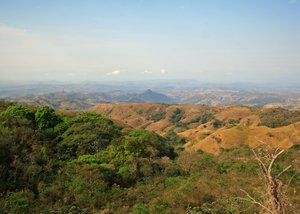Advertisement
Published: March 2nd 2010

 Monteverde
Monteverde
Just as few hundred yards from the very wet cloud forest, across the other side of the mountain, the climate suddenly changes into being dry and hot.An 08h00 start. Although not quite in the Cloud Forest, it was cool as we climbed aboard the bus. Leaving the hotel, we made our way through the village of Santa Elena and out towards the coast. Within a few hundred yards, the climate had completely changed from cool and wet to hot and very dry. The trees were no longer tall and covered in moss but much shorter and, more importantly, deciduous. A fine dust pervaded the air.
Continuing down the unmade road, we eventually arrived in Carara (meaning
crocodile). This area contains what is known as a transition forest with a mixture of lowland, hot tropical trees and the cooler, more humid cloud forest trees. The walk through the trees was extremely hot and the effort was not rewarded by views of the wildlife as it was very limited.
After a (poor) lunch by the Pacific, we made our way to Rio Tarcoles and a(nother) boat trip. We had the boat to ourselves and were given a checklist containing a list of 56 birds Setting off into the hot sun to find the birds, we were not disappointed as almost immediately we came across stork, osprey, jacana,
duck, ibis and heron and also iguana and basilisk.
Then our pilot spotted a large crocodile coming towards us and so, getting out of the boat, he grabbed some chicken (as you do) and started beating it into the water. As the crocodile got closer, it lifted its head, looking directly at the chicken (and the pilot's hand!) and came out of the water. The pilot then stepped back, dropping the chicken, which was literally snapped up by the crocodile.
Fearlessly, the pilot climbed back on board and we headed down river towards the sea. Just beyond the jetty, we received an SOS from a fisherman who had somehow embedded a hook in his thumb. After a quick return to the jetty to get the first aid kit from the bus, our guide cut the barb of the hook and the fisherman then pulled remnant of the hook from his finger. Iodine and a plaster later, we returned the fisherman to his boat and headed off back on our journey - catching sight of many more birds and, in the mangroves, crabs and a raccoon.
By now, it was 16h30 and the remainder of the day was
spent travelling to our next hotel, through heavy rain and lightening.
Advertisement
Tot: 0.082s; Tpl: 0.014s; cc: 9; qc: 37; dbt: 0.0378s; 1; m:domysql w:travelblog (10.17.0.13); sld: 1;
; mem: 1.1mb

 Monteverde
Monteverde










